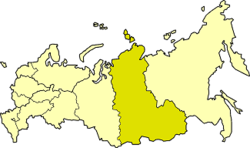East Siberian Economic Region: Difference between revisions
4% national output share |
Rescuing 1 sources and tagging 0 as dead. #IABot (v1.5.2) |
||
| Line 15: | Line 15: | ||
East SIberian economic region accounted for 4 per cent of the national GRP in 2008. This sparsely populated region between Europe and Asia has high wage levels and also a relatively large portion of employees in the new private sector. Productivity is also high by Russian standards. |
East SIberian economic region accounted for 4 per cent of the national GRP in 2008. This sparsely populated region between Europe and Asia has high wage levels and also a relatively large portion of employees in the new private sector. Productivity is also high by Russian standards. |
||
It ranks especially low in the migration of people into the region and population change, and in the expectation of life to improve and evaluation of the national economy. <ref>[http://www.abdn.ac.uk/cspp/East-Siberia-1.shtml East Siberia<!-- Bot generated title -->]</ref> |
It ranks especially low in the migration of people into the region and population change, and in the expectation of life to improve and evaluation of the national economy. <ref>[http://www.abdn.ac.uk/cspp/East-Siberia-1.shtml East Siberia<!-- Bot generated title -->] {{webarchive|url=https://web.archive.org/web/20070122130901/http://www.abdn.ac.uk/cspp/East-Siberia-1.shtml |date=2007-01-22 }}</ref> |
||
==References== |
==References== |
||
Revision as of 07:09, 16 September 2017
East Siberian economic region (Russian: Восто́чно-Сиби́рский экономи́ческий райо́н, Vostochno-Sibirsky ekonomichesky rayon) is one of twelve economic regions of Russia.

In this area of plateaus, mountains, and river basins, the major cities—Krasnoyarsk, Irkutsk, Ulan-Ude, and Chita—are located along the Trans-Siberian Railroad. A branch line links Ulan-Ude with Mongolia and Beijing, China. There are hydroelectric stations at Bratsk, Krasnoyarsk, and Irkutsk. Coal, gold, graphite, iron ore, aluminum ore, zinc, and lead are mined in the area, and livestock is raised. [1]
Composition
- Buryat Republic
- Irkutsk Oblast
- Republic of Khakassia
- Krasnoyarsk Krai
- Tuva Republic
- Zabaykalsky Krai
Socio-economic indicators
East SIberian economic region accounted for 4 per cent of the national GRP in 2008. This sparsely populated region between Europe and Asia has high wage levels and also a relatively large portion of employees in the new private sector. Productivity is also high by Russian standards.
It ranks especially low in the migration of people into the region and population change, and in the expectation of life to improve and evaluation of the national economy. [2]
References
